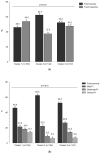Clusters of Sociodemographic Characteristics and Their Association with Food Insecurity in Mexican University Students
- PMID: 39200434
- PMCID: PMC11353896
- DOI: 10.3390/foods13162507
Clusters of Sociodemographic Characteristics and Their Association with Food Insecurity in Mexican University Students
Abstract
Food insecurity (FI) expresses irregular access to sufficient, safe, and nutritious food. We analyze the association between clusters of sociodemographic characteristics and FI in university students from Mexico. The Latin American and Caribbean Food Security Scale was applied, and household type, socioeconomic status (SES), and the characteristics of the head of the household, among others, were asked in a cross-sectional study. We performed Two-Step cluster analysis and logistic regression models. We included 466 university students (72.5% women, 47% with FI). We identified three clusters; Cluster-1 (n = 163) included a single-parent (37.4%) or co-resident/roommate (27%) household type, middle SES (63.2%); the head of the household is usually a woman (76.1%), single (71.8%), and with bachelor's degree (41.7%) or less educational level (46.6%). Cluster-2 (n = 144) included the nuclear (89.6%) household type, high SES (76.4%); the head of the household is usually a man (79.2%), in a relationship (99.3%), and with a bachelor's degree (63.2%) or graduate level (33.3%). Cluster-3 (n = 147) is very similar to Cluster-2. The difference is that Cluster-3 includes middle SES (70.1%), and the head of the household's educational level is high school or less (100%). Only belonging to Cluster-1 was positively associated with FI (OR = 1.96, 95%CI: 1.24, 3.09). These results show the interrelationships between multiple sociodemographic characteristics and should contribute to developing interventions that simultaneously address numerous sociodemographic factors to diminish FI in university students.
Keywords: cluster analysis; college students; food insecurity; food security; sociodemographic characteristics; university students.
Conflict of interest statement
The authors declare no conflicts of interest. The funders had no role in the design of the study; in the collection, analyses, or interpretation of data; in the writing of the manuscript; or in the decision to publish the results.
Figures


Similar articles
-
Prevalence and Risk Factors of Food Insecurity among Mexican University Students' Households.Nutrients. 2021 Sep 28;13(10):3426. doi: 10.3390/nu13103426. Nutrients. 2021. PMID: 34684437 Free PMC article.
-
Food insecurity was negatively associated with adherence to the "fruits, vegetables, and foods rich in animal protein" dietary pattern among university students' households: the 2018 Mexican National Household Survey.BMC Public Health. 2023 May 11;23(1):854. doi: 10.1186/s12889-023-15755-z. BMC Public Health. 2023. PMID: 37226130 Free PMC article.
-
Assessing the prevalence and potential drivers of food insecurity and the relationship with mental wellbeing in UK university students: A cross-sectional study.Nutr Bull. 2024 Mar;49(1):96-107. doi: 10.1111/nbu.12662. Epub 2024 Feb 4. Nutr Bull. 2024. PMID: 38311588
-
Prevalence and sociodemographic correlates of food insecurity among post-secondary students and non-students of similar age in Canada.BMC Public Health. 2023 May 25;23(1):954. doi: 10.1186/s12889-023-15756-y. BMC Public Health. 2023. PMID: 37231381 Free PMC article.
-
Sociodemographic Correlates of Food Insecurity in Students Attending a Private University: A Cross-Sectional, Descriptive Study.Cureus. 2022 Sep 9;14(9):e28987. doi: 10.7759/cureus.28987. eCollection 2022 Sep. Cureus. 2022. PMID: 36249612 Free PMC article.
Cited by
-
Associations of Sociodemographic Characteristics with Food Choice Motives' Importance Among Mexican Adults: A Cross-Sectional Analysis.Foods. 2025 Jan 7;14(2):158. doi: 10.3390/foods14020158. Foods. 2025. PMID: 39856824 Free PMC article.
References
-
- FAO Hambre e Inseguridad Alimentaria. [(accessed on 5 June 2020)]. Available online: http://www.fao.org/hunger/es/
-
- FAO. FIDA. OMS. PMA . In: UNICEF El Estado de La Seguridad Alimentaria y La Nutrición En El Mundo 2023. Urbanización, Transformación de Los Sistemas Agroalimentarios y Dietas Saludables a Lo Largo Del Continuo Rural-Urbano. 1st ed. FAO; IFAD; UNICEF; WFP; WHO, editor. FAO; Roma, Italy: 2023.
-
- Shamah-Levy T., Romero-Martínez M., Barrientos-Gutiérrez T., Cuevas-Nasu L., Bautista-Arredondo S., Colchero M., Gaona-Pineda E., Lazcano-Ponce E., Martínez-Barnetche J., Alpuche-Arana C., et al. Encuesta Nacional de Salud y Nutrición 2021 Sobre COVID-19. Resultados Nacionales. Instituto Nacional de Salud Pública; Cuernavaca, Mexico: 2022.
Grants and funding
LinkOut - more resources
Full Text Sources

